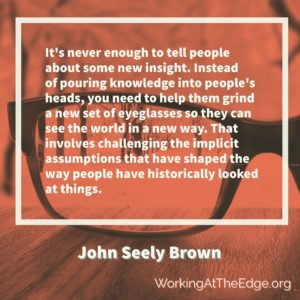 Have you ever been in a situation where you thought, “If I only had the power, I’d just make [insert task, idea, initiative, etc.] happen.” Or if you already have positional power, how much of your leadership consists of directing others––telling them what to do? Our natural inclination as humans is to want to win an argument and get people to do what we want done, and usually rather quickly and efficiently. Sadly, it’s one of the reasons why people seek positional power––they think get to tell people what to do. Once they have the position and the power, they take all of the agency and leave very little for anyone else.
Have you ever been in a situation where you thought, “If I only had the power, I’d just make [insert task, idea, initiative, etc.] happen.” Or if you already have positional power, how much of your leadership consists of directing others––telling them what to do? Our natural inclination as humans is to want to win an argument and get people to do what we want done, and usually rather quickly and efficiently. Sadly, it’s one of the reasons why people seek positional power––they think get to tell people what to do. Once they have the position and the power, they take all of the agency and leave very little for anyone else.
Effective leadership is more than winning an argument or telling people what to do, especially if you reframe leadership through the lens of agency. In Drive: The Surprising Truth About What Motivates Us, Daniel Pink shares three drivers of motivation––autonomy, mastery and purpose. When people lack the ability to exercise some form of autonomy or agency, they lack motivation. And a lack of motivation doesn’t bode well for change within an organization, especially complex change. People will resist your leadership, or they will begrudgingly carry out your orders and hope you move on real fast so they can go back to what they use to do.
The alternative do commanding others is enrollment. I first learned about enrollment while reading The Art of Possibility by Ben and Rosamund Zander. The authors devote an entire chapter to the possibilities offered by enrollment and capture its essence in these words;
Enrolling is not about forcing, cajoling, tricking, bargaining, pressuring, or guilt-tripping someone into doing something your way. Enrollment is the art and practice of generating a spark of possibility for others to share.
I later encountered this idea of enrollment during a Learning Lab Training by Education Reimagined. During the lab, we each had the opportunity to hone our leadership craft, practicing the art of enrolling others in the learner-centered paradigm.
The challenge with enrollment is that it task time and a certain craft/skill to respond to the unique context of each situation. The beauty of it, though, is that it preserves and honors the agency of those you are trying to enroll and deepens the human connection through extended conversation. The end result will be far more lasting if you’re willing to invest the time and energy into designing the possibilities of your ideas for others, your organization and yourself. I wrote about enrollment earlier, and you can read more about the process here.
One final though on reframing this aspect of leadership. Yes, there are times that leaders need to be directive; for example, when there is a crisis or an already established set of protocols, procedures or policies to implement. But if you are working to bring about transformation in your system and helping others understand a complex shift in vision and possibility, enrollment is the far better leadership choice.
After thinking about your leadership style, what is the balance of enrollment to direction? What are some first steps to shifting the balance?
Connect with Randy on Twitter, the TLTalkRadio podcast, and the Shift Your Paradigm podcast!
Get new content delivered to your inbox and the ebook 3 Key Principles of Digital Transformation. The ebook contains valuable information from my experience leading a digital transformation and working with a variety of stakeholders over the past decade.
- A silver lining - January 22, 2022
- Is our use of tech working against us? 🤔 - September 8, 2021
- What’s NOT going to change in the next 10 years? 🤔 - September 7, 2021